Standard [CURRENT]
ASTM E 981:2025
Standard Test Method for Estimating Sensory Irritancy of Airborne Chemicals
- German title
- Bestimmung der Reizwirkung von Luftschadstoffen
- Publication date
- 2025
- Original language
- English
- Pages
- 14
- Publication date
- 2025
- Original language
- English
- Pages
- 14
- DOI
- https://dx.doi.org/10.1520/E0981-25
Product information on this site:
Quick delivery via download or delivery service
Buy securely with a credit card or pay upon receipt of invoice
All transactions are encrypted
Short description
1.1 This laboratory test method provides a rapid means of determining sensory irritant potential of airborne chemicals or mixtures. It may also be used to estimate threshold limit values (TLV) for man. However, it cannot be used to evaluate the relative obnoxiousness of odors. 1.2 This test method is intended as a supplement to, not a replacement for, chronic inhalation studies used to establish allowable human tolerance levels. 1.3 This test method is arranged as follows: Section Scope 1 Referenced Documents 2 Terminology 3 Summary of Test Method 4 Significance and Use 5 Safety Precautions 6 Apparatus 7 Reagents 8 Hazards 9 Test Animals 10 Preparation of Apparatus 11 Sample Preparation 12 Calibration 13 Pretest Conditioning 14 Selection of Test Parameters 15 Procedure 16 Interpretation of Results 17 Reporting 18 Precision and Bias 19 Keywords 20 1.4 This standard does not purport to address all of the safety concerns, if any, associated with its use. It is the responsibility of the user of this standard to establish appropriate safety, health, and environmental practices and determine the applicability of regulatory limitations prior to use. Specific hazard information is given in Section 9 . 1.5 This international standard was developed in accordance with internationally recognized principles on standardization established in the Decision on Principles for the Development of International Standards, Guides and Recommendations issued by the World Trade Organization Technical Barriers to Trade (TBT) Committee.
ICS
13.040.01
DOI
https://dx.doi.org/10.1520/E0981-25
Also available in
Loading recommended items...
Loading recommended items...
Loading recommended items...
Loading recommended items...

